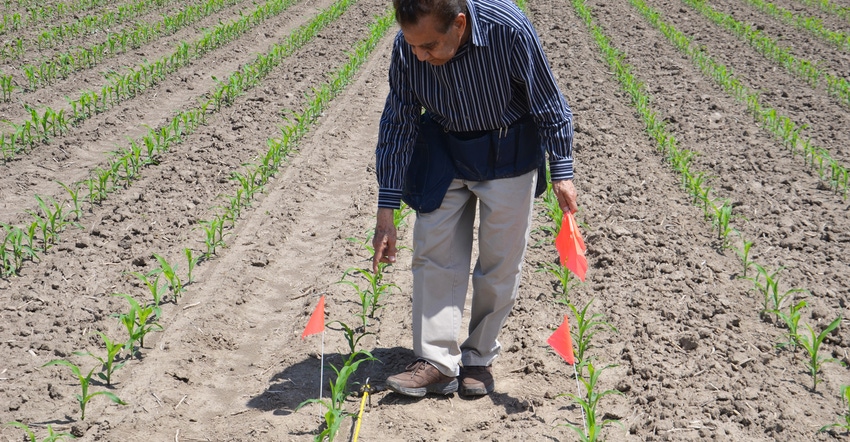
One of the first things Dave Nanda did on his initial visit to the Corn Watch ’19 field this year was pull out his yellow rope with steel stakes on each end and take a stand count. Nanda believes firmly in knowing plant population.
“You had a goal, but you need to know how close you came to it,” says Nanda, director of genetics for Seed Genetics-Direct, Jeffersonville, Ohio, and a consultant for the Corn Watch ’19 project. Seed Genetics-Direct sponsors Corn Watch ’19.
Nanda carries his measuring rope whenever he visits a field. It’s marked with tags at the right length to measure 1/1,000 of an acre, depending on row width. The operator of the Corn Watch ’19 field plants in 30-inch rows. For 30-inch rows, 1/1,000 of an acre equals 17 feet, 5 inches.
Nanda picks a spot at random and then counts plants down both sides of the rope. He averages the two to get a count for that spot. Ideally, you should repeat the count at least five times within a field to produce an average actual plant population for the field. If there are thin areas or areas where emergence was different, perhaps due to varying soil types, you may want to do a separate series of counts and determine population in each area.
The Corn Watch ’19 field was finally planted May 28 after weather delays. When Nanda visited in mid-June, corn was at the three-leaf stage. Since 180 pounds of actual nitrogen was applied as anhydrous ammonia with N-Serve in a spring application, corn plants were green and growing, despite a cool stretch.
The operator’s population goal was 32,000 plants per acre. Nanda determined a population of 31,500 plants per acre.
Why stand counts matter
Taking stand counts does two important things, Nanda says. First, it lets you know if the planter delivered a seeding rate that resulted in the stand you targeted. If the stand is well below the intended goal, the problem may be the planter, but it may also be due to other conditions that affected germination and emergence. Those could include soil crusting due to compaction and weather conditions during germination.
The earlier you make stand counts, the better chance you have at determining if gaps in a stand are due to a planter problem or some other cause.
The second reason for doing stand counts is so you know what kind of crop you have shaping up during the season, Nanda says. In the Corn Watch ’19 field, nitrogen was already applied. If you have fields where you planned to sidedress or were thinking about a late application of N, knowing the stand count might help you decide if investing in more nitrogen is justified. Do you have enough plants to still reach a high yield potential if fertilizer is sufficient and growing conditions are good?
Knowing stand populations and getting a better handle on yield potential as harvest approaches will also help you make more informed decisions about grain storage and crop marketing.
You can do stand counts even if corn has silked and pollinated, all the way to harvest. “It may not be much fun, but you can pull out the yellow rope and make counts any time,” Nanda says. “If ears are already on the plants, you can actually count harvestable ears.”
About the Author(s)
You May Also Like




